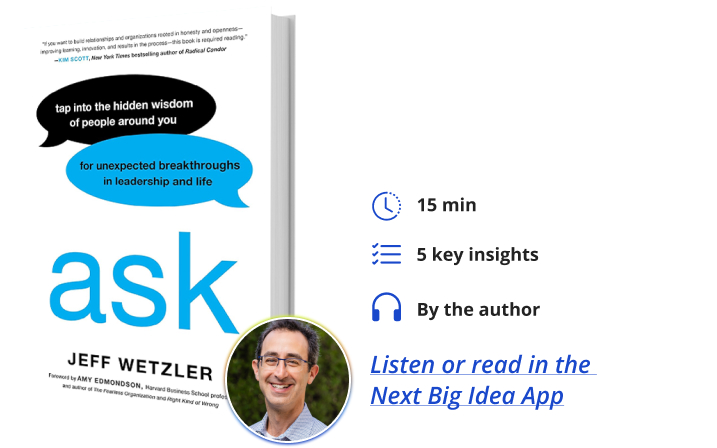Jeff Wetzler is an entrepreneur, management consultant, and co-CEO of Transcend, an organization seeking to spread equitable learning environments. Previously, he held senior positions at Teach for America, a nonprofit dedicated to educational opportunity for all children.
Below, Jeff shares five key insights from his new book, Ask: Tap Into the Hidden Wisdom of People Around You for Unexpected Breakthroughs In Leadership and Life. Listen to the audio version—read by Jeff himself—in the Next Big Idea App.

1. Choose curiosity.
What if I told you that some of the most important people in your life aren’t telling you what they really think, feel, and know? That’s right: your friends, family members, colleagues, and even your customers and clients are walking around with insights, ideas, feedback, and experiences that would be incredibly valuable for you to know. But if you’re like most people, too much of this treasure trove of information will forever stay hidden.
For example, one of the most common things people hold back from sharing is their feedback or advice for you. The people around you can see things about you that you just can’t. They can point out a blind spot in your strategic plan or gently observe an unhelpful pattern in your behavior. Most importantly, they are the only person who can tell you how you impact them. If something you were doing were inadvertently hurting someone or making things harder for them, you’d want to know. But most people don’t offer up that kind of feedback or ideas for what you could do better. It’s up to you to draw it out of them.
This is what led me to develop the Ask Approach. The Ask Approach consists of five highly effective, actionable steps that will deepen your self-awareness, help you make smarter decisions, and bring new levels of depth and meaning to your relationships.
It starts by choosing curiosity—awakening your genuine desire to understand what those around you really think, feel, and know. When authentically choosing curiosity, we make a powerful mental shift to focus on what we can learn. Each of us is constantly telling ourselves stories about our lives and the people in them. Our friend isn’t returning our calls because they’re secretly mad at us. Our coworker keeps missing deadlines because they just assume we will pick up the slack. We loop and loop, working ourselves into a tizzy of judgment and resentment and anxiety, so certain about our own perspective that we don’t get curious about what we might not be seeing.
We tend to default to certainty instead of curiosity due to a combination of psychological biases and cultural conditioning. It’s a survival strategy because we can’t possibly process all the data we are exposed to every day, so our minds instinctively select a small range of that information to make decisions and take action. We then promptly forget that the information we’re working with is only a tiny slice of the whole picture. Choosing curiosity is about breaking out of these certainty loops.
2. Make it safe.
To learn from others, you have to make it safe for them to share openly with you. Decades of research by Harvard Business School Professor Amy Edmondson and others have demonstrated that for people to speak up, they need to feel psychologically safe. They need to believe you will not judge, shame, or punish them for sharing. This is even more important when there’s any kind of power dynamic at play or if you are interacting across lines of difference, such as age, race, or gender, all of which can intensify the risks (real or perceived) of speaking candidly.
It’s amazing how often we underestimate just how much some people around us feel unsafe to tell the truth. It’s a painful realization—the idea that other people, even the people you love most, may not feel comfortable opening up fully with you. But recognizing this reality also empowers you to make it as safe, comfortable, and easy as possible for them to share.
“The fear of hurting, upsetting, or angering you is the number one reason people don’t tell you what they really think or feel.”
It starts by creating connection. When people feel genuinely connected to you, and you to them, you both feel safer. You can relax in one another’s company and tackle uncomfortable topics. One of the most effective ways to do this is to enrich and deepen your stories about one another. A question like, “What’s the story behind how you ended up doing what you do today?” can prompt people to share a part of themself you don’t already know while also allowing them to share only as much as they feel comfortable.
And you have to share, too. This starts with explaining why you’re asking a question, so they don’t have to guess your agenda. This way, they know up front that they’re not being tricked or misled into sharing something you could use against them.
It’s also important to communicate that you can handle whatever they have to say and that you won’t hold them responsible for any emotional reactions you have. The fear of hurting, upsetting, or angering you is the number one reason people don’t tell you what they really think or feel. Identifying and assuaging this fear upfront is often the permission slip people need to start sharing. But remember: once you make this promise, you have to keep it. This step takes vulnerability, but it’s a risk you have to take if you want others to open up.
3. Pose quality questions.
To find out what you most need to know, you have to pose quality questions. I’m convinced that the right question, asked in the right way, is the most powerful tool for learning and connection that we have.
Yet despite how powerful questions are, most of us have never actually learned how to pose good questions, or even what distinguishes a quality question from a crummy one. Too often, questions are motivated by a desire to convince, prove, blame, or even attack the other person. Yes/no questions, like, “Don’t you agree?” or those that put people on the defensive (“What were you thinking?”) do not produce valuable information and shut down conversations.
By contrast, quality questions signal true curiosity, reflecting a genuine intent to understand someone rather than prove a point or fix them. They invite honesty by being clear and direct, with no alternate agenda. Quality questions tap into the other person’s story to surface the underlying meanings, reasons, emotions, and experiences.
“Understanding your goal for asking the question is essential to choosing the right one for the job.”
Questions can be used for a variety of purposes. A question like, “What matters most to you in this situation?” can help you identify what someone really cares about, while asking, “Can you walk me through your thought process?” can surface the logic beneath their beliefs or actions. You can use questions to enlist someone’s help in solving a problem (“I’m stuck. Can you help me think this through?”) or find holes in your own reasoning by asking, “What do you think I might be missing?” Understanding your goal for asking the question is essential to choosing the right one for the job.
Questions can also be used to invite feedback. This kind of vulnerability can feel scary but often generates the most valuable information, especially when it comes to relationships. Too few of us ever ask about us. But questions like, “What could I be doing better here?” or “How did I contribute to the challenge we faced?” can bring issues to the light where they can be addressed instead of allowing them to fester beneath the surface.
4. Listen to learn.
One survey found that 96 percent of people think of themselves as good listeners, yet research shows that we hear (and retain) only a sliver of what people tell us. It’s easy to feel like you’re listening when what you’re really doing is waiting quietly until it’s your turn to respond or scanning the other person’s words for holes and ammunition. I’m as guilty of this as anyone, especially when the person shares things that feel hurtful or that I strongly disagree with.
But it’s in these situations that you most need to return to the question: What could I learn from this person? and then allow that intention to guide your listening. The only goal is to understand what the other person is trying to share. Everything else—even your very best counterpoints—must take a seat in order to free up the attentional resources to listen for multiple levels of meaning simultaneously. In fact, you need to triple how much you hear by listening to three channels at once.
Most people only listen through a single channel: the content of what others say. This includes the facts of the matter and the claims they are making. But to listen to learn, you must pay attention to two other channels: emotion and action.
“Most people only listen through a single channel: the content of what others say.”
With the emotion channel, we listen to understand what feelings are being communicated, including the needs and desires behind those feelings. Sometimes, I get so caught up in listening for facts that I forget to tune into the emotional information, but experience has taught me that this channel is not only incredibly rich but often most essential.
The action channel is about what they are doing through communicating with you. Maybe they are trying to persuade you or enlist your help with something. Listening to this channel doesn’t mean going along with their action; it’s about expanding your understanding of what they are trying to express.
5. Reflect and reconnect.
Finally, what do you do with what you hear? You might be tempted to immediately begin fixing or solving or even apologizing. But this is when it pays to pause and reflect. This is what lets you make sure you’re taking the right insights from what you heard. To do this, ask yourself these three questions:
• How might what I heard revise my story about the situation? This is your opportunity to nuance, challenge, or revise your prior understanding. Perhaps you realize there are aspects of the situation you weren’t thinking of or other conclusions you could draw.
• Based on what I heard, what action steps can I take? Here, you can find insights about what you can start, stop, or continue doing in response to what you heard.
• How might what I heard challenge my deeper worldviews, assumptions, or ways of being? This is the deepest and most emotional level of reflection and where the most important learning occurs. It can be painful, but this is where you can confront any not-so-pretty biases or prejudices you have internalized over your life and begin the hard work of unlearning them. It’s here that the greatest transformations occur.
Once you’ve reflected, reconnect with that person and let them know the meaning and impact that their sharing had on your life. I can’t emphasize enough how important this piece is. If you don’t reconnect, it can leave the other person feeling unappreciated or used. But when you take the time to share what you’ve learned, you open the door to deeper connection and ongoing learning that benefits you both.
Each of the five practices of the Ask Approach are powerful on their own, but together they are nothing short of a superpower. While these are powerful skills for individual people, organizations can also build a culture of inquiry through hiring practices, training, rewards, and the modeling that leaders do.
Looking around society, I see so many opportunities: challenges in desperate need of more curiosity, better questions, and deeper listening. Many of our most pressing issues are opportunities for us to turn toward each other, ask questions, and find new paths forward. I hope that the Ask Approach helps more people and organizations build the capabilities for tapping into the hidden wisdom of people and unlocking the collective genius all around.
To listen to the audio version read by author Jeff Wetzler, download the Next Big Idea App today:





























